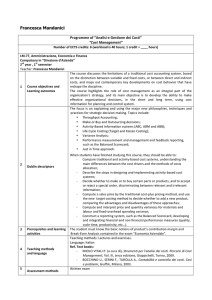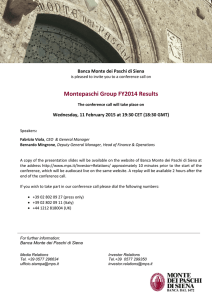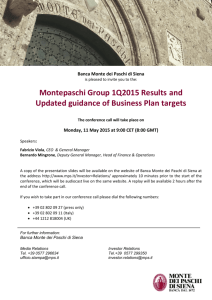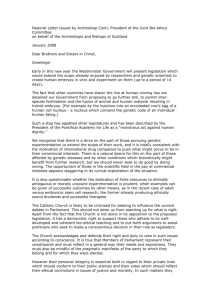The Business Intelligent System of the Italian Court of Audit
advertisement
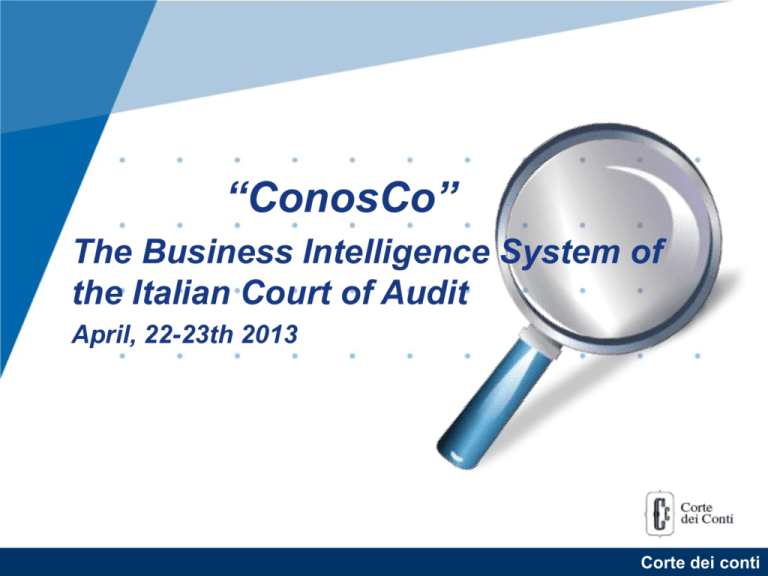
“ConosCo” The Business Intelligence System of the Italian Court of Audit April, 22-23th 2013 Corte dei conti Technological innovation in the Court of Audit The Court of Audit, in line with the Italian Public Administration modernization and innovation strategy, carries out initiatives aimed at: • Increasing the efficiency of the judicial administrative action • Improving the delivery of services to citizens • Reinforcement its institutional role and ....through an innovative approach based on the use of ICT Corte dei conti Technological innovation in the Court of Audit Inside the italian Court of Audit, the enhancement of technology has followed 3 main areas: • investment in information assets, development and evolution of operational information systems • investment in business intelligence advanced tools for data analysis • use of new methodologies for data analysis … and what are the the aims of this? Corte dei conti Aims of Technological innovation in the Court of Audit o simplification, rationalization and transparency of information o timeliness of data collection and monitoring o “Digitalization” or “dematerialization” (using the digital document) o strengthening instruments for quantitative and qualitative control of revenues and expenditures Corte dei conti Technological innovation in the Court of Audit: the Business Intelligence System The project of the business intelligence system “Conosco” was launched by the President of the Court of Audit in 2008 with the aim of identifying new tools for Public Finance control. Later, the project’s objectives and technical/operational requirements were defined in collaboration with IT Department of Italian Court and Consip (a public company particularly skilled in IT) Corte dei conti ConosCo – the aims ConosCo as an instrument to monitor public finance During the last years the Court of Audit has implemented its information technology infrastructure in order to better support its institutional activity, and has started many IT projects mainly concerning : 1. controlling and reporting activities on Ministries and other public bodies 2. controlling and reporting activities on local authorities 6 Corte dei conti Technological innovation in the Court of Audit: Why a Business Intelligence System? NEED: REQUEST: The continuous change of the social, political and economic context poses increasingly new questions, often extemporaneous, and increasingly complex decisions The satisfaction of “knowledge” needs requires the availability of complete, timely and reliable information and a specific IT solution The solution for addressing those needs and to support decision making, is called ... SOLUTION: Business Intelligence Corte dei conti Technological innovation in the Court of Audit: the Business Intelligence System What is it? Business Intelligence is a set of methodologies, processes, architectures, and technologies that transform raw data into meaningful and useful information. This information is used to enable more effective, strategic, tactical, and operational insights and decision-making, which are necessary for an organization to obtain and analyze data to support decision making and control. How is it done? Presentation Processes Methodologies Storaging Software Hardware Acquisition Statistics Processing Data Sources Corte dei conti Technological innovation in the Court of Audit: the Data Warehouse What is it? The “beating heart” of the system is the Data Warehouse “A subject-oriented, integrated, time-variant, non-volatile collection of data organised in support of management’s decision-making process.”* … for the Court of Audit that means Public Finance assessment and control * William (Bill) H. Inmon is considered the "father" of one of the main models of data warehouse Corte dei conti Technological innovation in the Court of Audit: the Data Warehouse What is it? A tool to assist the management to make decisions (knowing to decide): − A binder of information on “thematic areas" of interest (subject oriented); − A single coherent data collector (integrated) − A system that tracks information changes over time (time variant); − A set of homogeneous information that can not be modified by the user (non volatile); Corte dei conti Technological innovation in the Court of Audit: The Pyramid of this Information System: the relationship between business Intelligence, Data Warehouse and operational systems Processes Data Users Strategic Control Decision Making Synthetic Dashboard Information analysis and monitoring Analysts Aggregate Data Warehouse Operational Systems Management of Institutional and Organizational Processes Operational Detailed Corte dei conti Technological innovation in the Court of Audit: ConosCo DATA WAREHOUSE System Data Sources Functionality Central Gov. Finance Area Dashboard - Indicators DM Central Gov. Finance SIRGS-CDC Local Gov. Finance Area SIRTEL SIQuEL Query DM Local Gov. Finance Jurisdiction & Attorney Area SISP EDW Report DM SISP Personnel Area SIAP*- CDC DM Personnel Quality e metadata Corte dei conti Central Gov. Finance Data Mart what are the controlling and reporting activities on Ministries and other public bodies? Expenditures Money Orders Payments Account of residual assets and liabilities passed on to the following balance sheet Treasury flows SIRGS: Revenues Revenue Receipts from BKI Public revenue Balance balance-sheet items Ministerial Decrees Administrative measures Cdc SicogeSipa-Igepa… State assets Assets Integrated Information Systems (12) of the State General Accounting Department Corte dei conti Local Gov. Finance Data Mart www.corteconti.it XML •cross checks carried out Information System - SIRTEL in automatic mode •Error reporting in real time to local Administrations. Data storage The Local Administration sends the final balance in XML file format 50.000 balance items from each local authority Report to Parliament 14 Corte dei conti Technological innovation in the Court of Audit: data integration The decision to build the Court of Audit data warehouse with a single data container (“Enterprise DW”) allows a subsequent rapid implementation of new thematic Data Marts. Public Finance Regional Finance Central Gov. Finance Local Gov. Finanza Locale Finance Public agencies Corte dei conti ConosCo overview Data integrator of different information systems in order to: • perform complex financial analysis • share information and results of the analysis with some other public bodies • obtain information in real time through financial indicators concerning revenue, expenditure, …. • monitor expenditure’s trend of the Public Administration • produce graphical representations 16 Corte dei conti ConosCo characteristics • • • • Modular (new datamarts) Incremental (data and analysis) Customizable (analysis and indicators) Historicized (current data and time series) Finanza Locale Corte dei conti ConosCo: the Data Warehouse characteristics Quality and Metadata Characteristics Data Quality is the measure of the conformity degree between the expected data in the system and the rules of Business It determines the ability to transform the data into useful and reliable information Poor data quality spreads QUALITY Poor quality of data is expensive Data quality can be improved Corte dei conti ConosCo: the Data Warehouse characteristics Quality and Metadata Characteristics The information needed to contextualize the data - Indicator Tab Indicator name Description Data source unit measure Algorithm calculation threshold METADATA Business Metadata (synthetic) financial autonomy : Own Revenue/Current Revenue Corte dei conti ConosCo – multidimensional analysis Economic classification Geographical Economic classification View Time View Geographical View Multidimensional View classification Time 1.500 Amount Corte dei conti ConosCo – multidimensional analysis It’ also possible the «drill down» Corte dei conti ConosCo – multidimensional analysis Data correlation Revenues Expenses Corte dei conti ConosCo – dashboard dashboard: synthetic and intuitive representation of the most important financial indicators on public expenditure This dashboard represents the expenditure of a chosen Ministry through a set of indicators an indexes 23 Corte dei conti ConosCo – dashboard Dashboards are available to analyze the economic and financial management of local authorities through synthetic indicators Corte dei conti ConosCo – complex report In one click you can obtain a report on local authorities economic and financial management (250 pages) Corte dei conti ConosCo – Integration with office tools Corte dei conti ConosCo – MOBILE functionality Tablet SmartPhone Corte dei conti About the Change Management – the changes and the benefits CHANGES INTRODUCED BY ConosCo Significant time savings in the production of the report and analysis The BENEFITS • Real-time analysis • Easy access to information • Quality of work Reduction of routine and repetetive works • Reduction of errors in tables processing • Data Integration Shared work mode and new ways of working in offices and between offices • Sharing information, results and analysis methodologies •Dynamic and flexible reporting Change in processes verification and monitoring • Availability of synthetic indicators • Time Series, cluster Analysis Corte dei conti Thanks • I think there is a world market for maybe 4-5 computers (Thomas Watson IBM Chairman, 1943) • Future enters into us, in order to transform itself in us, long before it happens (R.M. Rilke) Corte dei conti




